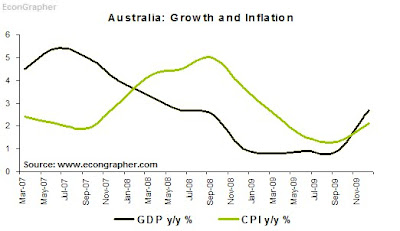The RBA (Reserve Bank of Australia) increased its benchmark interest rate 25 basis points to 4.25%, making it the 5th increase this tightening cycle. The move was a close call and was only predicted by about half (13 of 23) of economists surveyed by Bloomberg.

Jumping straight to the last paragraph of the RBA's media release; indications are that there will be more rate hikes to come:
 The outlook for the Australian economy is reasonably buoyant, indeed the comments in the monetary policy decision media release certainly paint a bright picture:
The outlook for the Australian economy is reasonably buoyant, indeed the comments in the monetary policy decision media release certainly paint a bright picture:
Sources:
Econ Grapher Analytics www.econgrapher.com
Reserve Bank of Australia www.rba.gov.au
Australian Bureau of Statistics www.abs.gov.au
Article Source: http://www.econgrapher.com/6apr-rba.html

Jumping straight to the last paragraph of the RBA's media release; indications are that there will be more rate hikes to come:
Interest rates to most borrowers nonetheless have been somewhat lower than average. The Board judges that with growth likely to be around trend and inflation close to target over the coming year, it is appropriate for interest rates to be closer to average. Today’s decision is a further step in that process.Australia continues to lead the charge on monetary policy tightening as the strength of the Australian economy, and near-trend inflationary conditions, make it difficult to argue for historically loose monetary policy rates.
 The outlook for the Australian economy is reasonably buoyant, indeed the comments in the monetary policy decision media release certainly paint a bright picture:
The outlook for the Australian economy is reasonably buoyant, indeed the comments in the monetary policy decision media release certainly paint a bright picture:Australia’s terms of trade are rising, adding to incomes and fostering a build-up in investment in the resources sector. Under these conditions, output growth over the year ahead is likely to exceed that seen last year, even though the effects of earlier expansionary policy measures will be diminishing.But obviously Australia isn't the only economy experiencing a strong recovery and a resurgence of inflationary pressures. There's some emerging market economies for example that are arguably better positioned than Australia growth-wise, and who face greater inflation risks. So the question is: Who's next?
The rate of unemployment appears to have peaked at a much lower level than earlier expected. The process of business sector de-leveraging is moderating, with the pace of the decline in business credit lessening and indications that lenders are starting to become more willing to lend to some borrowers.
Credit for housing has been expanding at a solid pace. New loan approvals for housing have moderated over recent months as interest rates have risen and the impact of large grants to first-home buyers has tailed off. Nonetheless, at this point the market for established dwellings is still characterised by considerable buoyancy, with prices continuing to increase in the early part of 2010.
Sources:
Econ Grapher Analytics www.econgrapher.com
Reserve Bank of Australia www.rba.gov.au
Australian Bureau of Statistics www.abs.gov.au
Article Source: http://www.econgrapher.com/6apr-rba.html